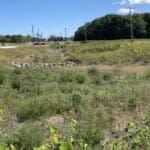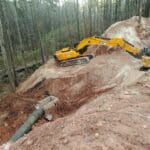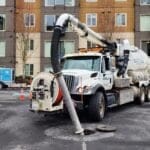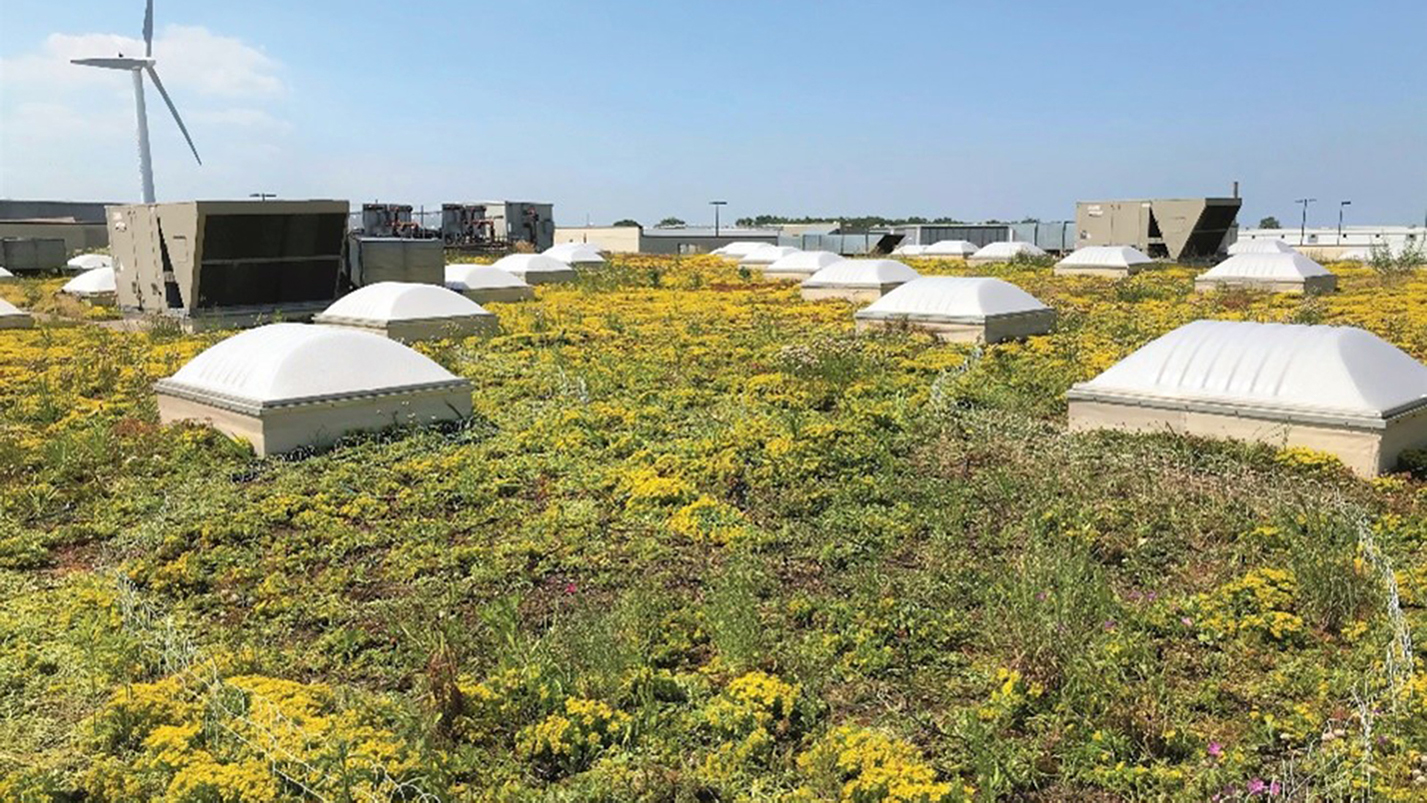City of Burlington
The City of Burlington established a dedicated stormwater program in 2009 in an effort to address the state and federal stormwater permit requirements. This program collects stormwater user fees from property owners in Burlington which are used to fund efforts to meet or exceed specific compliance requirements in the City’s stormwater permit as well as improve stormwater management throughout the City. Fully addressing these requirements is key to improving the water quality of Lake Champlain and the Winooski River, as well as the streams that flow into them. The City of Burlington has enacted an ordinance to the City code which sets forth requirements for the management of stormwater both during and after construction. All properties are to be compliant with the standards and requirements explained in the ordinance.
The MS4 permit, in particular, drives stormwater management in affected cities and regions, including Burlington. This permit articulates several mandatory minimum control measures to curb non-point source pollution generated by stormwater. This permit was first issued in 2003 and was renewed in 2008 with new, more stringent requirements that could not be met without a dedicated stormwater program.
Burlington, VT Stormwater Ordinance-Chapter 26
ARTICLE III. STORMWATER AND EROSION CONTROL
DIVISION 1. GENERALLY
26-96 Applicability.
(a) Except as exempted under subsection (d) below, this article shall apply to all property within the City of Burlington, and shall apply specifically to:
- Construction activities that include land disturbance activities and are subject to major impact, subdivision, and/or planned unit development zoning permit review as defined in the comprehensive development ordinance, and/or are subject to building permit or approval under any regulation or ordinance of the City of Burlington;
- Any construction activity that include land disturbance activities of four hundred (400) square feet or more and are subject to zoning permit review other than noted in subsection (a) above and/or are subject to building permit or approval under any regulation or ordinance of the City of Burlington;
- Any condition or activity, regardless of the amount of impervious surface or disturbed area proposed, where there exists any hydrological condition which may lead to offsite sediment runoff or other pollutant load to a public sewer or natural outlet.
- Illegal discharges and/or connections into any premise, public or private property, driveway, parking area, street, alley, sidewalk, component of the MS4, CS, or public sewer.
(b) All projects, conditions, and activities that are subject to this article must meet the minimum requirements of this article, and reserved.
(Ord. of 12-15-08(2), § 26-3-1)
26-97 Application requirements.
(a) Unless otherwise exempted or waived by this article, every zoning permit application involving major impact, subdivision, and/or planned unit development review per section 26-96(a)(1) shall be accompanied by the following, as applicable:
- A written approval from the department of public works for discharge to or connection with public sewers;
- An “erosion prevention and sediment control (ESPC) plan”;
- A “stormwater management plan”; and
- A written determination from the department of Public Works that the project for which a permit is requested complies with the City’s MS4 general permit, CS discharge permit and the Vermont Stormwater Manual design requirements.
(b) Unless otherwise exempted or waived by this article, every other project, condition or activity per section 26-96(a)(2) and (3) shall be accompanied by the following, as applicable:
- A written approval from the department of public works for discharge to or connection with public sewers;
- A completed small project erosion and sediment control plan approved in writing by the department of public works;
- A “stormwater management plan”; and
- A written determination from the department of public works that the project for which a permit is requested complies with the city’s MS4 general permit, CS discharge permit and the Vermont Stormwater Manual design requirements.
(c) Prior to commencement of the project, condition, or activity, the applicant shall submit site plans and designs and any supporting documentation to the department of public works for review and approval. No project, condition, or activity shall commence until the department of public works has reviewed and issued a written approval.
(d) The city shall prescribe the form(s) and information that shall be submitted to determine compliance with this article, with sufficient copies for necessary referrals and records.
(Ord. of 12-15-08(2), § 26-3-2)
26-98 Responsibilities.
(a) The department of public works, in consultation with the department of planning and zoning, shall administer and implement the provisions of this article. The code enforcement office shall enforce the provisions of this article in the event of a violation.
(b) The standards set forth herein and promulgated pursuant to this article are minimum standards; therefore this article does not intend nor imply that compliance by any person will ensure that there will be no contamination, pollution, nor unauthorized discharge or discharge of pollutants.
(Ord. of 12-15-08(2), § 26-3-3)
DIVISION 2. ILLEGAL DISCHARGES
26-112 Prohibitions.
(a) Illicit connections.
- No person shall throw, deposit, leave, maintain, keep, or permit to be thrown, deposited, left, or maintained, in or upon any premise, public or private property, driveway, parking area, street, alley, sidewalk, component of the MS4, CS or public sewer, or any surface water of the City of Burlington, any object or material, including but not limited to: water, refuse, rubbish, garbage, animal waste, litter, yard waste, or other discarded or abandoned objects, articles, and accumulations, so that the same may cause or contribute to pollution, or interfere with the operation, maintenance and access to the MS4, CS or public sewer. Wastes deposited in streets in proper waste receptacles for the purposes of collection are exempted from this prohibition.
- The construction, use, maintenance or continued existence of illicit connections to the MS4, CS or public sewer is prohibited.
- This prohibition expressly includes, without limitation, illicit connections made in the past, regardless of whether the connection was permissible under law or practices applicable or prevailing at the time of connection.
(b) Illegal discharges.
- No person shall discharge or cause to be discharged into the MS4, any materials, including but not limited to pollutants or waters containing any pollutants, other than stormwater, or any materials that may impede the natural flow of stormwater or the functionality of the MS4 without first receiving written authorization from the director upon a determination that such discharge is in compliance with this division and other applicable city ordinances, regulations or permits.
- No person shall discharge or cause to be discharged into the CS and/or public sewer without first receiving written authorization from the director upon a determination that such discharge is in compliance with the city’s Final Discharge Permit No. 3-1331, 3-1247 and 3-1245, Part 1, Section F. Combined Sewer Overflows and Section I. Sewer Ordinance as issued and as amended by the State of Vermont; and the provisions of the City of Burlington Ordinances.
(Ord. of 12-15-08(2), § 26-3-5)
26-114 Industrial or construction activity discharges.
Any person subject to an industrial or construction activity NPDES stormwater discharge regulation, and/or permit shall comply with all provisions of such regulation and/or permit. Proof of compliance with said regulation and/or permit may be required in a form acceptable to the director prior to the allowing of discharges to the MS4.
(Ord. of 12-15-08(2), § 26-3-7)
26-116 Control, prevention and reduction of stormwater pollutants.
The owner or operator of a commercial or industrial establishment shall provide, at their own expense, reasonable protection from accidental discharge of prohibited materials or other wastes into the MS4, and/or surface or groundwater, CS or public sewer through the use of structural and nonstructural BMPs. Further, any person responsible for a property or premises, which is, or may be, the source of an illegal discharge and/or illicit connection, may be required to implement, at said person’s expense, additional structural and nonstructural BMPs to prevent the further discharge of pollutants to the MS4, and/or surface or groundwater, CS or public sewer. Compliance with all terms and conditions of a valid NPDES or MSGP permit, a state post-construction (operational) stormwater management permit, a zoning permit, a building permit or approval under any regulation or ordinance of the city authorizing the discharge of stormwater, shall be deemed to be in compliance with the provisions of this section.
(Ord. of 12-15-08(2), § 26-3-9)
26-117 Notification of spills.
Notwithstanding other requirements of law, as soon as any person responsible for a premises or operation, or responsible for emergency response for a premises or operation has information of any known or suspected release of materials which are resulting or may result in illegal discharges or pollutants discharging into the MS4, and/or surface or groundwater, CS or public sewer, said person shall take all necessary steps to ensure the discovery, containment, and cleanup of such release. In the event of such a release of hazardous materials said person shall immediately notify emergency response agencies of the occurrence via emergency dispatch services. In the event of a release of nonhazardous materials, said person shall notify the department of public works either in person, by phone, or facsimile no later than the next business day. Notifications in person or by phone shall be confirmed by written notice addressed and mailed to the department of public works within three (3) business days of the phone notice.
If the discharge of prohibited materials emanates from a commercial or industrial establishment, the owner or operator of such establishment shall also retain an onsite written record of the discharge, steps taken to remediate said illicit discharge, and the actions taken to prevent its recurrence. Such records shall be retained on site by the owner or operator for at least three (3) years.
(Ord. of 12-15-08(2), § 26-3-10)
DIVISION 4. STORMWATER MANAGEMENT
26-155 Stormwater manual.
The stormwater manual as referenced in this article refers to the technical analysis and design standards specified in the Vermont Stormwater Manual (Volumes I and II), latest revision and to the City of Burlington, Department of Public Works Stormwater and Erosion Control Specifications, Standards and Management Practices Design Manual.
(Ord. of 12-15-08(2), § 26-3-23)
26-156 Stormwater treatment standards and treatment practice design criteria.
The following stormwater treatment standards may apply to those projects, conditions and activities regulated under this division and where applicable, shall be applied as required and outlined in the Vermont Stormwater Manual, (Volumes I and II), latest revision, to the maximum extent practicable as determined by the director of the department of public works.
- Water quality treatment standards.
- Channel protection treatment standards.
- Groundwater recharge treatment standards.
- Over bank flood protection treatment standards.
- Extreme flood protection treatment standards and, where applicable,
- Hydraulic capacity standard. In instances where discharges, connections and/or releases of stormwater are to city public sewers, infrastructure, and/or facilities, the applicant must make demonstration to the satisfaction of the director at the department of public works that the public sewer, infrastructure and/or facility has the hydraulic capacity to accommodate the anticipated stormwater runoff flows and volumes without burdening or creating an adverse impact on such infrastructure and facilities. If the hydraulic capacity analyses shows city infrastructure will be exceeded and/or burdened, the applicant may seek to mitigate such impacts through flow reduction, retention, detention, infiltration and/or water re-use stormwater management practices upon the approval of the director on a case-by-case basis.
(Ord. of 12-15-08(2), § 26-3-24)
26-157 Use of alternative stormwater management practices.
The city recognizes that in some instances the ability to strictly meet the requirements of section 26-156, stormwater treatment standards and treatment practice design criteria, may not be possible, feasible or desired in an urban landscape. As such the city encourages the use of alternative management practices and technologies as a way to both satisfy the requirements of this division, to give flexibility to design and to encourage green Infrastructure (green), best management practices (BMP), low impact design (LID) or other innovative practices that in the opinion of the department of public works satisfies the requirements of this division. Such practices include but are not limited to, green roofs, alternative detention practices, water reuse, including stormwater use, infiltration practices, including pervious and porous pavements and pavers. See Burlington’s Guidelines for Stormwater Pollutant Reduction, September 1999 and as may be amended and EPA “Managing Wet Weather with Green Infrastructure Action Strategy”, January 2008, and as amended.
Persons subject to this division may utilize alternative stormwater management practices as a means of meeting the standards established in section 26-156. Persons seeking to employ any alternative practice must provide descriptions and standard details as well as a make a demonstration that such alternative practice meets or exceeds the standards of section 26-156, that the standards of section 26-156 are not applicable, and/or the alternative practice mitigates the impact that section 26-156 seeks to address, subject to the department of public works for review and approval. A maintenance and a installation guide shall also be provided to ensure the materials are properly installed. When considering any alternative stormwater management practice, the department of public works will evaluate and determine if such practice is consistent with the city MS4, CSO and use of public sewers permits and ordinances, including this chapter. Where such management practices are found to be consistent with or likely not to compromise the city MS4, CSO and use of public sewers permits and ordinances, the department of public works may grant their use on a case-by-case basis.
(Ord. of 12-15-08(2), § 26-3-25)
26-158 Stormwater management plan.
(a) Review and approval. The department of public works will review each stormwater management plan to determine its conformance with the provisions of this division, unless such review is explicitly exempted within this division. Within thirty (30) days after receiving a complete plan and application, the department of public works shall in writing:
- Approve the plan;
- Approve the plan subject to such reasonable conditions as may be necessary to secure substantially the objectives of this division, and require that the issuance of the zoning permit and/or building permit be subject to these conditions; or
- Disapprove the plan, indicating the reason(s) and procedure for submitting a revised plan.
(b) Plan requirements. The stormwater management plan shall be prepared and signed by a licensed, professional engineer who shall verify and demonstrate conformance to the applicable water quality treatment standards and stormwater management design criteria contained in this division. The stormwater management plan shall contain both narrative and map(s) that clearly provide the following information:
- Contact information. The name, address, and telephone number of all persons having a legal interest in the property and the tax reference number and parcel number of the property or properties affected and similar information on the persons charged with the responsibility of constructing, maintaining and managing such stormwater systems.
- Site plan. A map indicating the location of existing and proposed buildings, roads, parking areas, utilities, structural stormwater management and sediment control facilities. The map will also clearly show proposed land use with tabulation of total lot size in acres, percentage of surface areas to be disturbed, percentage of existing and proposed impervious surfaces, drainage patters, locations of utilities, limits of clearing and grading, and all easements, including those easements necessary for required maintenance of all stormwater treatment practices.
- Base map. A one (1) inch = two hundred (200) feet topographic base map of the site which extends a minimum of three hundred (300) feet beyond the limits of the proposed development and indicates existing surface water drainage including streams, ponds, culverts, ditches, and wetlands, including associated buffer zones, and current land use including all existing buildings, utilities, roads, and significant natural and manmade features not otherwise shown.
- Calculations. Sufficient engineering analysis to show that the proposed stormwater treatment practices are capable of controlling runoff from the site in compliance with this division and the Vermont Stormwater Manual. The analysis shall also include hydrologic and hydraulic design calculations for the pre-development and post-development conditions for the design storms specified in the department of public works design manual with specific emphasis on demonstrating how post-development flows are maintained for discharges to the MS4 and/or where applicable demonstrating how post-development flows are detained for discharges to the CS.
- Soils report. A soils report that addresses the hydrologic properties of onsite soils shall be submitted. The soils report and accompanying information shall be based on the Operation maintenance and repair plan. The design and planning of all stormwater management facilities shall include detailed operation maintenance and repair procedures to ensure their continued function. These plans will identify the parts or components of a stormwater management facility that needs to be maintained. The operation and maintenance and repair plan shall also include:
- Operation maintenance and repair plan. The design and planning of all stormwater management facilities shall include detailed operation maintenance and repair procedures to ensure their continued function. These plans will identify the parts or components of a stormwater management facility that needs to be maintained. The operation and maintenance and repair plan shall also include:
a. A landscape plan. The applicant must present a detailed plan for the management of vegetation at the site after construction is finished, including who will be responsible for the maintenance of vegetation at the site and what practices will be employed to ensure that adequate vegetation cover is preserved.
b. Maintenance easements. Prior to the issuance of any permit that has a stormwater management facility as a requirement, the applicant or owner of the site must execute a maintenance easement that shall be binding on all subsequent owners of land served by the stormwater management facility. The purpose of the maintenance easement shall be to allow access to the stormwater management facility to perform maintenance as required by the maintenance agreement noted in subsection c. below. The easement shall provide for access to the facility at reasonable times for periodic inspection by the city, or its contractor or agent, and for regular or special assessments of property owners to ensure that the facility is maintained in proper working condition to meet design standards and any other provisions established by this section. The property owner shall record such easement, in a form and format approved by the city attorney, in the city land records with the city clerk’s office.
c. Maintenance agreement. The applicant must execute a maintenance agreement binding on all subsequent owners of land served by an onsite stormwater management measure. The maintenance agreement shall be recorded in the land records before the issuance of a building permit and shall specify the required maintenance for all stormwater treatment practices, along with a maintenance schedule specifying when and how often maintenance is performed on the stormwater treatment practices and a demonstrated financial ability to perform such maintenance. Such agreement shall be in a form and format approved by the city attorney, and be filed in the city land records. The owner is responsible for maintenance of stormwater management facilities; however, the city may accept dedication of existing or future stormwater management facilities for public maintenance and inspection.
d. Maintenance inspections. All stormwater management facilities must be inspected by the department of public works no less than once annually to identify maintenance and repair needs and to ensure compliance with the requirements of this division. Any identified maintenance and/or repair needs found must be promptly addressed by the responsible party. The inspection and maintenance requirement may be increased as deemed necessary by the city to ensure proper functioning of the stormwater management facility.
e. Records of installation and maintenance activities. Parties responsible for the inspection, operation and maintenance of a stormwater management facility shall make records of the installation and of all maintenance and repairs and shall retain the records for at least five (5) years. These records shall be made available to the director upon request and/or as specifically outlined in the maintenance covenant.
f. Failure to maintain practices. If a responsible party fails or refuses to meet the requirements of the maintenance covenant, the city, after proper notice, may correct a violation of the design standards or maintenance needs by performing all necessary work to place the facility in proper working condition and/or shall handle the matter as a violation per section 26-4, penalties and enforcement.
7 . Landscaping and stabilization requirements. Any area of land for which the natural vegetative cover has been either partially or wholly cleared or removed by land disturbance activities subject to this division shall be revegetated within ten (10) business days from the substantial completion of such clearing and construction. Additionally, the following requirements apply until such time as final site stabilization has been achieved:
a. Reseeding must be done with an annual or perennial cover crop accompanied by placement of straw mulch or its equivalent of sufficient coverage to control erosion until such time as the cover crop is established over ninety (90) percent of the seeded area.
b. Replanting with native woody and herbaceous vegetation must be accompanied by placement of straw mulch or its equivalent of sufficient coverage to control erosion until the plantings are established and are capable of controlling erosion.
c. Any area of revegetation must exhibit survival of a minimum of seventy-five (75) percent of the cover crop throughout the year immediately following revegetation. Revegetation must be repeated in successive years until the minimum seventy-five (75) percent survival for one (1) year is achieved.
d. Any and all accumulated sediments transported offsite and deposited onto city streets, and sidewalks shall be routinely and frequently swept up to prevent their discharge into stormwater and/or the city’s public sewer.
(Ord. of 12-15-08(2), § 26-3-26)
26-160 City inspections during installation and construction.
The applicant must notify the department of public works or their designee in advance before the start of construction and/or installation of any stormwater management system to alert the department of public works so they may arrange to make regular inspections of the construction of stormwater treatment practices and/or connections to any city infrastructure. If any violations are found, the property owner shall be notified in writing of the nature of the violation and the required corrective actions and shall be subject to the enforcement provision of section 26-4. No additional work shall proceed until any violations are corrected and all work previously completed has received approval from the department of public works.
In lieu of the requirements outlined in this section, the department of public works at their discretion may allow or require that the applicant or their agent provide a written certification from a professionally licensed engineer certifying compliance to the stormwater management plan as approved.
(Ord. of 12-15-08(2), § 26-3-28)
DIVISION 5. STORMWATER SYSTEM USER FEES
26-171 Establishment of stormwater user fees.
(a) A user fee based on an impervious surface unit (ISU) shall be imposed on every owner of non-exempt developed property within the city. An ISU shall equal one thousand (1,000) square feet.
(b) The city council shall have the authority to set and modify the user fee rates so that the total revenue generated by said charges, and any secondary sources of revenue, shall be sufficient to fund the city’s stormwater program.
(c) The city council shall establish by resolution the monthly rate for each ISU. The monthly user fee for a specific property is determined by multiplying the ISU rate times the number of ISUs on the property.
(d) The only exempt properties under this division are those included within the limits of a railroad track right-of-way (property on which railroad stations, maintenance buildings, or other developed land used for railroad purposes is located shall not be exempt) and those included within the limits of a public road right-of-way.
(Ord. of 12-15-08(2), § 26-3-29)
26-172 Establishment of ISUs.
(a) The following residential property types shall be allocated ISUs based on the group averages and shall be charged a monthly flat fee based on the group average.
- Detached single-family home (not including mobile home) = 2.67 ISUs.
- Two-unit home = 2.65 ISUs.
- Three-unit home = 3.06 ISUs.
(b) The ISUs allocated to all other property types shall be determined as follows:
- The amount of impervious surface on each parcel shall be calculated in square feet. That total shall be converted to ISUs for every one thousand (1,000) square feet and rounded to the nearest hundred (i.e. a commercial property with four thousand seven hundred eighty (4,780) square feet would have 4.78 ISUs).
- The user fee would be based on the number of ISUs (i.e. commercial property with 4.78 ISUs would pay the monthly user fee times 4.78).
- Owners of property subject to this subsection shall have the right to contest, in writing to the director, the number of ISUs allocated to their property. In such event, an onsite inspection and calculation of impervious surface shall be conducted jointly by the property owner (or representative) and the director to determine the number of ISUs. Such determination shall be made by the director, and such decision may be appealed to the public works commission within fifteen (15) days of the determination.
(Ord. of 12-15-08(2), § 26-3-30)
26-173 Credits.
(a) Institutional properties with impervious surface within a publicly owned nontraditional separate MS4 system shall receive a credit on their stormwater user fee. This credit applies only to impervious surfaces within the boundaries of the publicly owned non-traditional separate MS4 system.
(b) Properties not subject to a flat fee may be eligible for a credit on their stormwater user fee. Credits shall be available to properties that reduce the volume, or improve the water quality, of stormwater runoff. The degree of credit shall be based on the degree of reduction in stormwater runoff volume and/or the degree of water quality improvement of stormwater runoff. No credit shall exceed fifty (50) percent of the stormwater user fee, and in no event shall any credit result in a stormwater user fee below the flat fee for a single -family home. Credits shall be reviewed and assessed by the director based on the rules and procedures contained in the Stormwater User Fee Credit Manual. Any award of credit shall be conditioned on continuing compliance with the city’s design and performance standards as stated in the manual and/or upon continuing provision of the systems, facilities, services, and activities provided, operated, and maintained by the property owner or owners upon which the credit is based. The director may revoke a credit at any time for noncompliance by providing thirty (30) days written notice of a noncomplying condition and intent to revoke the credit to the property owner. If the noncompliance is not cured within the thirty (30) day period, the director shall eliminate the credit. A property owner may appeal the director’s determination regarding credit revocation to the public works commission within fifteen (15) days of the determination.
(Ord. of 12-15-08(2), § 26-3-31)
Burlington Stormwater Documents

 Kenosha, Wis. Highway KR Regenerative Stormwater ConveyanceThe Root-Pike Watershed Initiative Network Kenosha County, and others worked with AQUALIS to design and implement an innovative solution for stormwater control along Highway KR.
Kenosha, Wis. Highway KR Regenerative Stormwater ConveyanceThe Root-Pike Watershed Initiative Network Kenosha County, and others worked with AQUALIS to design and implement an innovative solution for stormwater control along Highway KR. Durham, N.C. Sinkhole Leads to Stormwater System RehabilitationThe tenant on this property noticed a depression that opened to the ground below and notified the property owners.
Durham, N.C. Sinkhole Leads to Stormwater System RehabilitationThe tenant on this property noticed a depression that opened to the ground below and notified the property owners.

